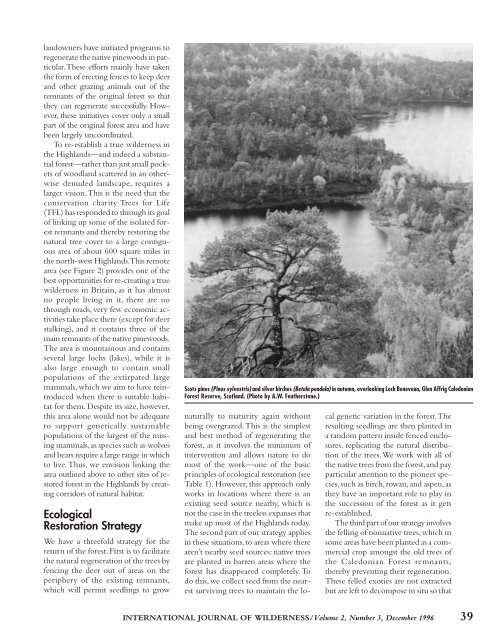P3-Vol 2.No3 Dec 96 - International Journal of Wilderness
P3-Vol 2.No3 Dec 96 - International Journal of Wilderness
P3-Vol 2.No3 Dec 96 - International Journal of Wilderness
Create successful ePaper yourself
Turn your PDF publications into a flip-book with our unique Google optimized e-Paper software.
landowners have initiated programs to<br />
regenerate the native pinewoods in particular.<br />
These efforts mainly have taken<br />
the form <strong>of</strong> erecting fences to keep deer<br />
and other grazing animals out <strong>of</strong> the<br />
remnants <strong>of</strong> the original forest so that<br />
they can regenerate successfully. However,<br />
these initiatives cover only a small<br />
part <strong>of</strong> the original forest area and have<br />
been largely uncoordinated.<br />
To re-establish a true wilderness in<br />
the Highlands—and indeed a substantial<br />
forest—rather than just small pockets<br />
<strong>of</strong> woodland scattered in an otherwise<br />
denuded landscape, requires a<br />
larger vision. This is the need that the<br />
conservation charity Trees for Life<br />
(TFL) has responded to through its goal<br />
<strong>of</strong> linking up some <strong>of</strong> the isolated forest<br />
remnants and thereby restoring the<br />
natural tree cover to a large contiguous<br />
area <strong>of</strong> about 600 square miles in<br />
the north-west Highlands. This remote<br />
area (see Figure 2) provides one <strong>of</strong> the<br />
best opportunities for re-creating a true<br />
wilderness in Britain, as it has almost<br />
no people living in it, there are no<br />
through roads, very few economic activities<br />
take place there (except for deer<br />
stalking), and it contains three <strong>of</strong> the<br />
main remnants <strong>of</strong> the native pinewoods.<br />
The area is mountainous and contains<br />
several large lochs (lakes), while it is<br />
also large enough to contain small<br />
populations <strong>of</strong> the extirpated large<br />
mammals, which we aim to have reintroduced<br />
when there is suitable habitat<br />
for them. Despite its size, however,<br />
this area alone would not be adequate<br />
to support genetically sustainable<br />
populations <strong>of</strong> the largest <strong>of</strong> the missing<br />
mammals, as species such as wolves<br />
and bears require a large range in which<br />
to live. Thus, we envision linking the<br />
area outlined above to other sites <strong>of</strong> restored<br />
forest in the Highlands by creating<br />
corridors <strong>of</strong> natural habitat.<br />
Ecological<br />
Restoration Strategy<br />
We have a threefold strategy for the<br />
return <strong>of</strong> the forest. First is to facilitate<br />
the natural regeneration <strong>of</strong> the trees by<br />
fencing the deer out <strong>of</strong> areas on the<br />
periphery <strong>of</strong> the existing remnants,<br />
which will permit seedlings to grow<br />
Scots pines (Pinus sylvestris) and silver birches (Betula pendula) in autumn, overlooking Loch Benevean, Glen Affrig Caledonian<br />
Forest Reserve, Scotland. (Photo by A.W. Featherstone.)<br />
naturally to maturity again without<br />
being overgrazed. This is the simplest<br />
and best method <strong>of</strong> regenerating the<br />
forest, as it involves the minimum <strong>of</strong><br />
intervention and allows nature to do<br />
most <strong>of</strong> the work—one <strong>of</strong> the basic<br />
principles <strong>of</strong> ecological restoration (see<br />
Table 1). However, this approach only<br />
works in locations where there is an<br />
existing seed source nearby, which is<br />
not the case in the treeless expanses that<br />
make up most <strong>of</strong> the Highlands today.<br />
The second part <strong>of</strong> our strategy applies<br />
in these situations, to areas where there<br />
aren’t nearby seed sources: native trees<br />
are planted in barren areas where the<br />
forest has disappeared completely. To<br />
do this, we collect seed from the nearest<br />
surviving trees to maintain the lo-<br />
cal genetic variation in the forest. The<br />
resulting seedlings are then planted in<br />
a random pattern inside fenced enclosures,<br />
replicating the natural distribution<br />
<strong>of</strong> the trees. We work with all <strong>of</strong><br />
the native trees from the forest, and pay<br />
particular attention to the pioneer species,<br />
such as birch, rowan, and aspen, as<br />
they have an important role to play in<br />
the succession <strong>of</strong> the forest as it gets<br />
re-established.<br />
The third part <strong>of</strong> our strategy involves<br />
the felling <strong>of</strong> nonnative trees, which in<br />
some areas have been planted as a commercial<br />
crop amongst the old trees <strong>of</strong><br />
the Caledonian Forest remnants,<br />
thereby preventing their regeneration.<br />
These felled exotics are not extracted<br />
but are left to decompose in situ so that<br />
INTERNATIONAL JOURNAL OF WILDERNESS/<strong>Vol</strong>ume 2, Number 3, <strong>Dec</strong>ember 19<strong>96</strong> 39










